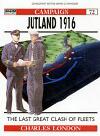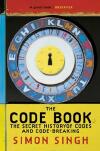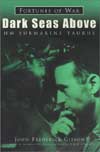Jutland 1916
Clash of the dreadnoughts
London, Charles
2000, Osprey Pub Co
ISBN 1855329921
Paperback, 96 pages, illustrations
| Type. | General History |
| Pros. | Good summary, if unremarkable conclusions. Emotive but not sentimental description of of otherwise unimaginable & alien Great War naval fighting, strategy, tactics, technology, leadership. |
| Cons. | Poor use of good graphics & artwork; text sometimes too brief for satisfaction, even given limits of serial volume. |
| Rating. |  |
 Charles London's solid but brief account is a useful companion to the battle, with an appendix on wargaming (quite a challenge, apparently!). It is more debatable whether it teaches us anything new. The limits of space in this serial volume mean that sections, such as his very good summaries of the development of the opposing British and German battlefleets, the key personalities, and the preceding course of the war at sea, end just when they are becoming developed. This leaves the reader feeling unsatisfied. There is an extensive bibliography of works for further reading. For all but the most dedicated and well-equipped, such lists usually create more problems and less clarity, especially with highly specific and often personal early accounts.
Charles London's solid but brief account is a useful companion to the battle, with an appendix on wargaming (quite a challenge, apparently!). It is more debatable whether it teaches us anything new. The limits of space in this serial volume mean that sections, such as his very good summaries of the development of the opposing British and German battlefleets, the key personalities, and the preceding course of the war at sea, end just when they are becoming developed. This leaves the reader feeling unsatisfied. There is an extensive bibliography of works for further reading. For all but the most dedicated and well-equipped, such lists usually create more problems and less clarity, especially with highly specific and often personal early accounts.
The significance of U-boats to these vast and almost unique surface operations is however the key to understanding them and the war at sea. The strategic paralysis that mines and the submarine torpedo imposed upon major warships led to the maintenance of two vast fleets unable to come into contact save on three occasions during the Great War, Jutland being the most massive. The risks of losing capital ships to the enemy, with all the dangers of balance and prestige, governed everyone's actions, but more so the Royal Navy's. Jellicoe refused to put his only sea-plane carrier, HMS Campania, and thus all his air cover (such as it was) in harm’s way. He "would not send her through the U-Boat lines alone." One wonders what the escort of Campania by a few destroyers spared from the many screening Jellicoe's battleships would have made to the strategic and tactical situation. It may have made the difference, if the funnel and cordite smoke, and the growing dark, had not been too thick too soon.
Here in any case is the key to understanding the use of the ships, added to careful and restrained remarks about Jellicoe's infamous caution. The fog of war meant that everyone was much more limited in their options than any collection of memoirs, photographs and maps normally indicate. London's use of images and graphics serve as much to point out the fog of war as to alleviate it for us. His choice of images is good, though necessarily limited by dependence on many static and poorly composed official portrait-type shots of individual warships for the purpose of illustrating the narrative and themes. This continues to be a failing of serial works of this size and scale, and also of the times about which the author is writing. There are few German images of the battle, and many British images are of their own battlecruisers exploding. Effective well-composed action photographs were simply not a priority at the time.
The arrangement of the commissioned artwork and graphics are more problematic. Once again this is more a failing of the publisher than the author. The artwork of major incidents is good, if unremarkable - and less effective than the equivalents specially painted in Germany in the 1920s. The "birds-eye" computer-graphic views of the lines of warships sit across double pages and are thus distorted by the binding. Key events in the centre of view are bent down and hidden or partially obscured, negating much of the value of displaying the groups of vessels in this manner. It is not a new technique, as it was done with photographs of tiny models as early as the 1950s, in large-format popular works. It ought to have been done in a more effective and better-set manner here.
Overall it is a solid and workmanlike account, if rather undistinguished in terms of its analysis from the multitude of predecessors. Beyond remarks about the limits and differences of the personalities involved, the unforeseen effects of tradition and largely untried technology on initiative, and the inevitable fog of war, it merely says the minimum about every aspect. The cautious (but not overcautious) and populist Jellicoe, the brash and distant Beatty, the committed and brave Hipper and Scheer, as well as their political guru Tirpitz, are all illustrated well.
Only in the narrative does Charles London really shine. Here he brings home the reality of war at sea in 1916: giant steel animals stampeding across a hostile medium, filled with largely blinded, deafened groups of humans with fragile bodies, exposed or trapped outside or inside according to their position. These fragile humans were at risk from steam, explosive, machinery and seawater. The author brings to us, merely by his use of diction, the danger and fear of these essentially alien experiences. Men in this book are not killed or dead in a painless instant, as is usual in such books. Here they are mashed by machinery, scythed and gutted by shell splinters, most of those lost burned to death by cordite igniting in the confined spaces of turret or handling room, a particular feature of ships hit.
We see the agony of (albeit anonymous) individuals on both sides. We also see the bravery and commitment which made it all possible. The professional bravery of Scheer and Hipper only turning away in the face of greater numbers and the risk of entrapment, not from a mere fight. The bravery of Beatty in charging on with obviously flawed ships around and beneath him. We also see the ordinary bravery of men who were not in charge and who had no say in their fate. One is the oft-repeated tale of Boy 1st Class Jack Cornwell (later posthumous VC), mortally wounded on an RN cruiser, who remained, dying, quietly by his gun for orders that never came, until the end.
We also see, aboard the mangled and slowly sinking (though she was got safely into harbour) SMS Seitlitz, the response of stokers and engine-room men to the order to charge the British fleet. At a key moment Scheer ordered his subordinate Hipper, already with damaged battlecruisers, to run at the British to cover the escape of the High Seas Fleet. When the order "At the enemy! Charge him (Angriff, Seitlitz!") was passed round the ship, there was a pause, then up the voicepipes from below came the noise of cheering and the hammering of shovels upon bulkheads and firebox doors. This may all be apocryphal. They can also be interpreted as inspirational, poignant, or chilling, according to your political and social leanings. I find them all three. They are also, in combination with the description of risk and injury given above, fairly unusual in brief and serial works on such battles. They elevate the book above mere technical accounts and popular works for fans on the subject. London has done the men who fought, and their experiences, a great service, and that is good enough.
The reviewer welcomes your comments on this review.
Review written by Ian Campbell, Launceston, Tasmania.
Published on 28 Mar 2002.
Purchase information: (info) Get Jutland 1916 now at amazon.co.uk (£ 14.99)
Get Jutland 1916 now at amazon.co.uk (£ 14.99)
Return to our main review page.



